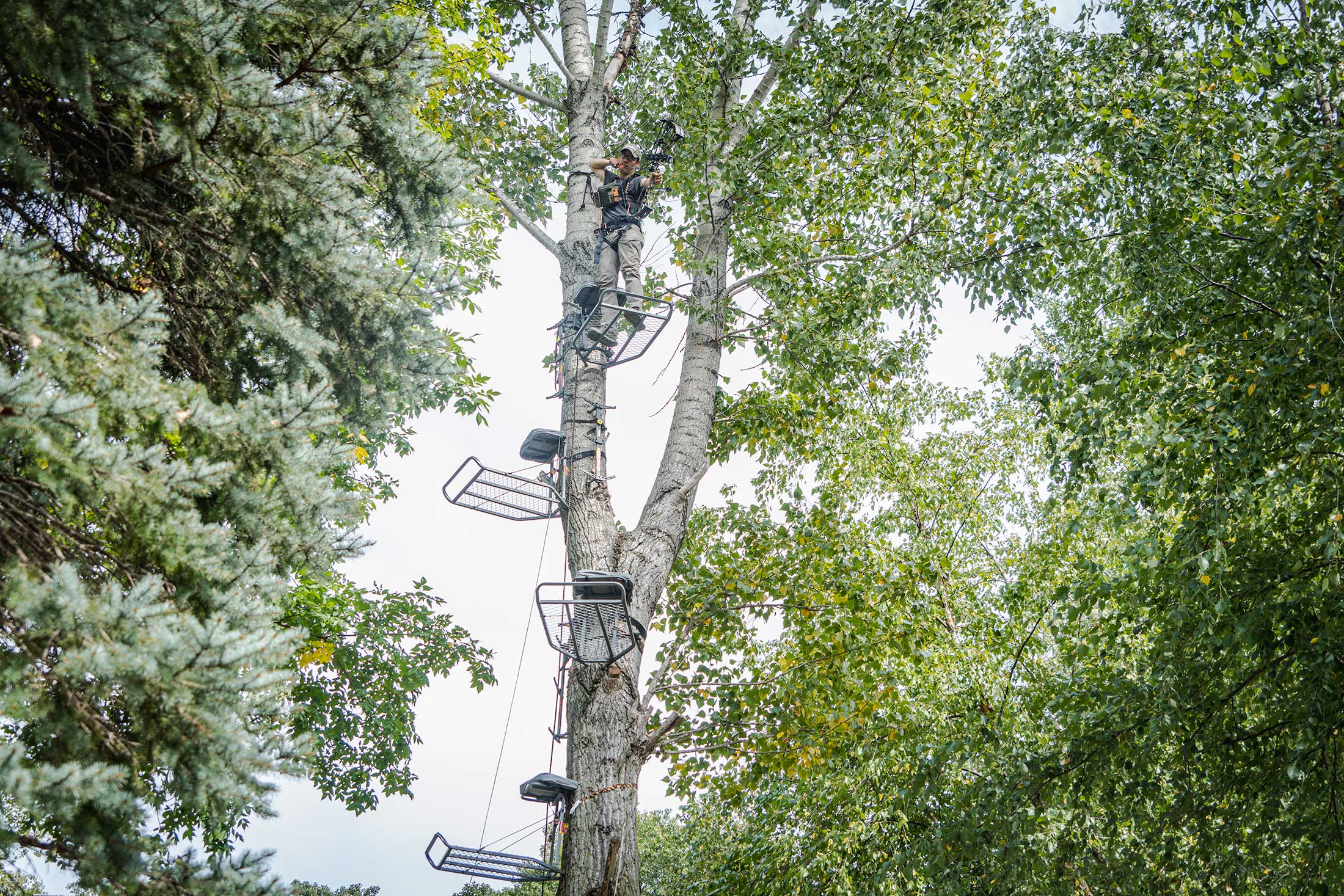Video: Testing the Best Treestand Height for Bowhunting

If you want to slay big bucks, you better draw a 70-pound bow and hang your treestand at least 25 feet up.
Or, maybe not. There are a handful of articles and videos out there about selecting the proper treestand height. Most of them mention the 20-foot mark as a sort of standard. Then there are hunters who argue for climbing even higher so you’ll be less easy to spot and less likely to be smelled. On the flip side, some hunters argue for hanging lower, so that you have a better shot angle at close-range deer.
So who’s right? I decided to actually test these theories to help illustrate the pros and cons of bowhunting and shooting at different heights. Here’s how I did this backyard test and what I found.
The Test
I hung four treestands in my backyard, all in the same tree. I hung them at heights of 10 feet, 15 feet, 20 feet, and 25 feet. I then placed a 3D deer target at 18 yards from the tree, measured the angle from each height (with my Bushnell R5 Series Rangefinder) and then did some shooting. I conducted this test on a day with 10 mph winds, that gusted maybe to 15 mph.
After shooting I evaluated entry and exit points in the target and looked at how the different heights allowed for vertical margin of error on a double-lung shot. The chest of my 3D target measures 14 inches, or about the same size as a small whitetail.
At each height I also used a wind checker to evaluate how scent might drift down to deer, or above them.
Variables to Consider
Concealment
In general, the higher you are, the harder it will be for a deer to spot you. However height is not the only factor in a sneaky good stand, in fact, it might not even be the most important. The amount of cover you have behind and around you is the real key. In an ideal scenario, you’ll be hunting in a tree that’s wider than your shoulders and has limbs branching out around you, to break up your profile. In this case you can get away with hunting lower.
Shot Angle & Presentation
The higher you hunt, the more difficult the shot. Remember that the average distance for a bow shot is about 20 yards. The higher you climb the steeper that shot angle becomes. These are the approximate shot angles measured from each height with the Bushnell R5 rangefinder:
- 10 Feet: 15 degrees
- 15 Feet: 20 degrees
- 20 Feet: 25 degrees
- 25 Feet: 30 degrees
Steep shot angles are challenging for a couple reasons. First, very steep target presentations offer less margin for error vertically. In other words, if your shot is really steep, it’s harder to hit both lungs. On a high-angle shot, you need to hit higher on the deer so that the arrow exits the bottom of the offside lung. But if you hit too high, you’ll miss the frontside lung.
Second, it’s simply harder to shoot a bow well at a steep angle. I experienced this first hand while shooting from the 25-foot mark. At that height the tree was swaying more in the breeze (a major challenge when trying to shoot accurately). Plus, the downward angle was so extreme that it was harder for me to keep consistent form. I just didn’t feel comfortable.
Scent
The hunt-higher camp will say that when you’re 25-plus-feet up, your scent will catch thermals and blow over the top of deer, instead of down to them. While using my wind checker 25 feet up, I did notice that it was blowing away and not down to the ground. I do believe that if a deer had been 15 or 20 yards downwind of me, my scent would have blown over the top of it.
However, the scent would drift down to deer height eventually. Deer that were maybe 100 yards away would certainly smell me. Hunting higher isn’t going to make you undetectable to a whitetail’s nose, but it might give you a slight advantage on close-range deer.
Treestand Height Takeaways
After shooting lots of arrows and evaluating my hits, I settled on a few specific takeaways. The first and most important point is to always use a safety harness and a lifeline when hunting and hanging treestands. If you are going to fall out of a stand, it’s most likely going to be when you’re climbing into it or out of it, so being harnessed up only while in the stand is not enough. You must be connected to a safety system from the moment you leave the ground.
You’re Not As High As You Think
One of the things I noticed right away is that very few hunters are actually climbing to 20 feet or higher (measured from the base of the stand to the ground). And an honest 25 feet was shockingly high.
For example, to hit the 20-foot mark, a long-legged hunter would need at least four climbing sticks, if he spaced them out very aggressively. But most of us would need five or six climbing sticks to hit that height comfortably.
Even the treestand gear isn’t marketed accurately when it comes to heights. For example, the lifeline system I used in this video says it was good for hunting up to 30 feet. However it wouldn’t even reach our 25-foot height (again, measured to the base of the stand). I had to use two tethers to get up to 25 feet.
Most of the stands that I’ve seen hung by other hunters on public land or on outfitted properties are about 15 feet and lower. The hang-and-hunt guys are unlikely to be climbing higher than 15 feet if they’re only packing in three to four sticks.
Shot Angle Isn’t a Problem at 10 to 20 Feet
At average archery ranges shooting from from 10 to 20 feet up in a tree should be relatively easy for a practiced archer. At any of these angles, if you shoot the buck through the top of the heart (entry) the arrow will come through the bottom of the heart (exit) and you’ll have a short blood trail.
However a very close 10-yard shot from 20 feet up will create a super-steep shot angle and a marginal shot presentation.
Shot Angle Becomes a Problem at 25 Feet and Higher
At average archery ranges, you’re making your shot much more challenging if you hunt higher than 20 feet. The margin of error is less and the shooting itself is more difficult. I think most hunters would be wise to hunt at 20 feet or lower (again, measured from the bottom of the stand).
15 Feet Is the Sweet Spot (for Me)
For me, an ideal treestand height is about 15 feet to 18 feet and an ideal shooting range is 15 to 20 yards. This offers a good amount of concealment and reasonable shot angles. If you can hunt lower while still hiding well, go for it.
But the real takeaway here is to not get obsessed with treestand height. Knowing how to hide your stand in a tree and when to move on a deer is more important than the height at which you’re hunting. There’s no shortcut to fooling a mature buck. You’ve got to do all the little things right, not just hang your stand an extra five feet higher.
Read the full article here







